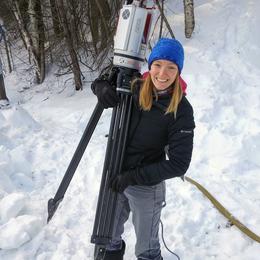Hannah Weiss is Audubon Vermont’s UVM Conservation Education Fellow for 2019, a position which involves broad participation in the organization’s many conservation and nature education initiatives. These articles are part of a series of “field notes” pieces, written to give the community a fellow’s-eye view of the exciting and important work being done by Audubon Vermont every day.
HUNTINGTON and JERICHO, Vermont (July 29, 2019) -
This week, I join Steve to learn about the second half of Audubon’s slogan: “protecting birds and the places they need, today and tomorrow”.
Steve Hagenbuch is a conservation biologist with Audubon Vermont and focuses on protecting bird habitat. We will tackle several projects this week centered around promoting forest management with birds in mind, beginning with our home base, the Green Mountain Audubon Center. Our goal of the day is to update a land stewardship plan originally created in 2005.
This management plan has not been updated since 2005, so we will follow the gridded pattern on Steve’s map and analyze the 255 acre property. The methods I learn today will be used to assess other properties later in the week.
We begin on a hot, humid July day – one of those days where I was sweating, though standing still. The Rubentstein Conservation Education Fellow from last summer, Sam Blair (who wrote some great articles during his time with Audubon – see here!), joins us, as he is currently working with Steve as a summer intern. We follow a map on Steve’s high-tech iPad and reach the first plot. It’s off-trail and requires a fair amount of bush-whacking. Later, I learn that Steve is not only a great forester and birder, but also a Master Bush-whacker.
Once at the plot, Steve instructs me to plunge a stick into the ground – this will be our plot center. He then instructs me in the somewhat magical-seeming art of the prism. The prism is apparently an established forester’s tool to determine which trees to measure and which to not measure. It is easier to explain via demonstration, than written word. The main idea is to only count trees that are of a certain size, and the further away a tree is, the larger it must be to be included in the count of trees within our plot.
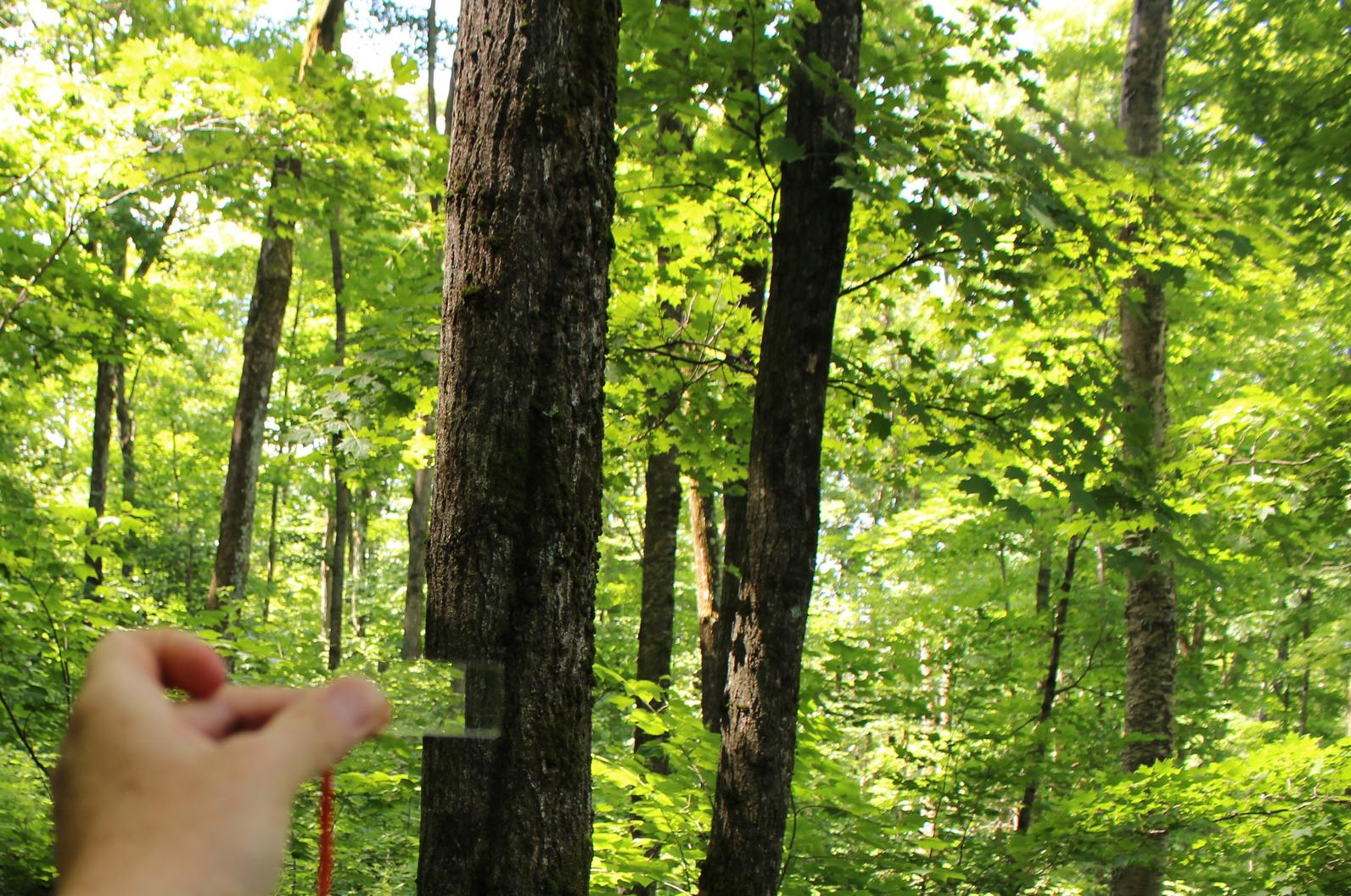
After counting and identifying trees – the sugar maple, paper birch, and hemlock are most common – we unroll a tape measure and count a radius around the plot center of 59 feet, which is a quarter-acre. Within this quarter-acre, we estimate canopy-cover (how much sky we can see if only looking at the top layer of trees), mid-story cover (how much sky if only looking at trees between 6 feet and 30 feet) and understory cover (6 feet and below). In a smaller circle (a tenth of an acre) we count fallen trees measuring more than 10 inches diameter that we call “course woody debris” and determine if there are any piles of “fine woody debris” (sticks/branches within which birds could hide). Each of these variables is part of forest structure, which is important in providing nesting habitat for a variety of birds.
We also keep our eyes open for invasive plants (we might find buckthorn, honeysuckle, or barberry), and note the birds we either see or hear. Steve identifies by call a Scarlet Tanager, a Winter Wren, and a Black-capped Chickadee. I also learn of Sam Blair’s hidden talent: guessing tree DBH correctly. His accuracy astounds me! (DBH = diameter of the tree at breast height).
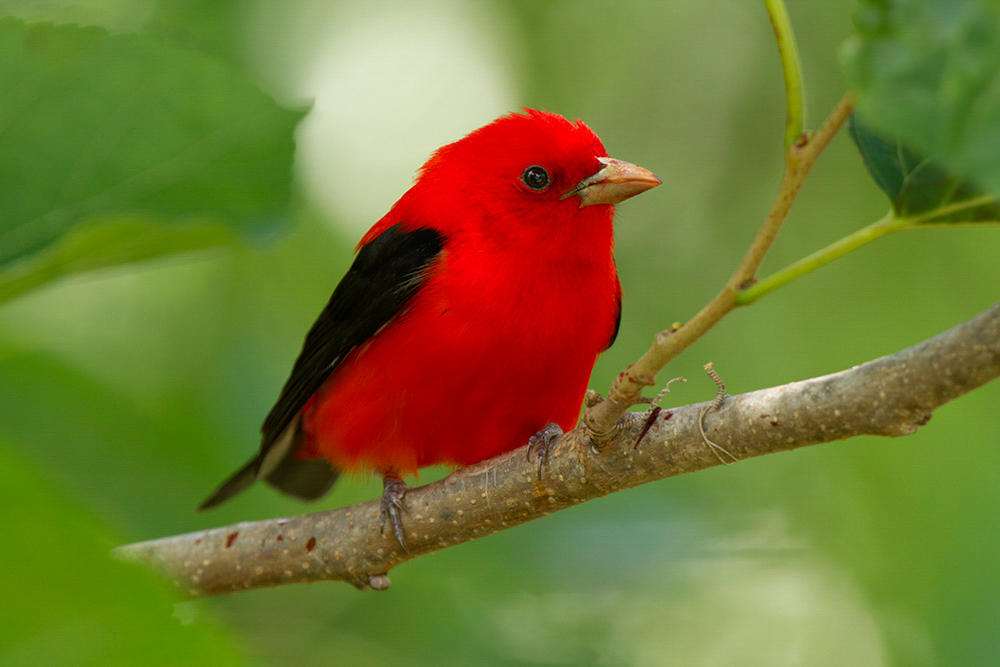
We repeat this process several more times, at several more sites, with bush-whacking in-between. By the time we’re done, I’ve gained several battle wounds from the pickers and sticks and have completely sweated through my cotton shirt (a silly wardrobe decision on a humid day). And, I feel prepared for tomorrow’s expedition to a sugarbush in Underhill: the Proctor Maple Research Center.
The second day’s project is to manage bird habitat around sugarbushes (sugar maple stands managed and tapped by maple syrup producers). Steve’s master’s degree centered on the implications of maple sugarbush management for songbirds, which has led him to develop the Bird Friendly Maple Project.
Sugaring operations voluntarily participate in the Bird Friendly Maple Project. Usually, a maple producer will reach out to Steve with an interest in acquiring the flashy label on their maple syrup. Steve will review their current forest management plan and then do a site-visit to analyze the property himself. Once he has walked the property, he will write up a report detailing the current condition of the property, where the gaps are in terms of managing the forest with birds in mind, and suggesting how to manage to better protect birds. The producer must sign off that they will follow the suggested amendments to their current management plan. Once signed, they receive the labels, educational materials, and promotional materials.
Currently, thirty-seven operations participate in the project. These operations range from 200 taps to over 100,000 taps and are spread throughout Vermont (including the Green Mountain Audubon Center - see this past year’s event!).
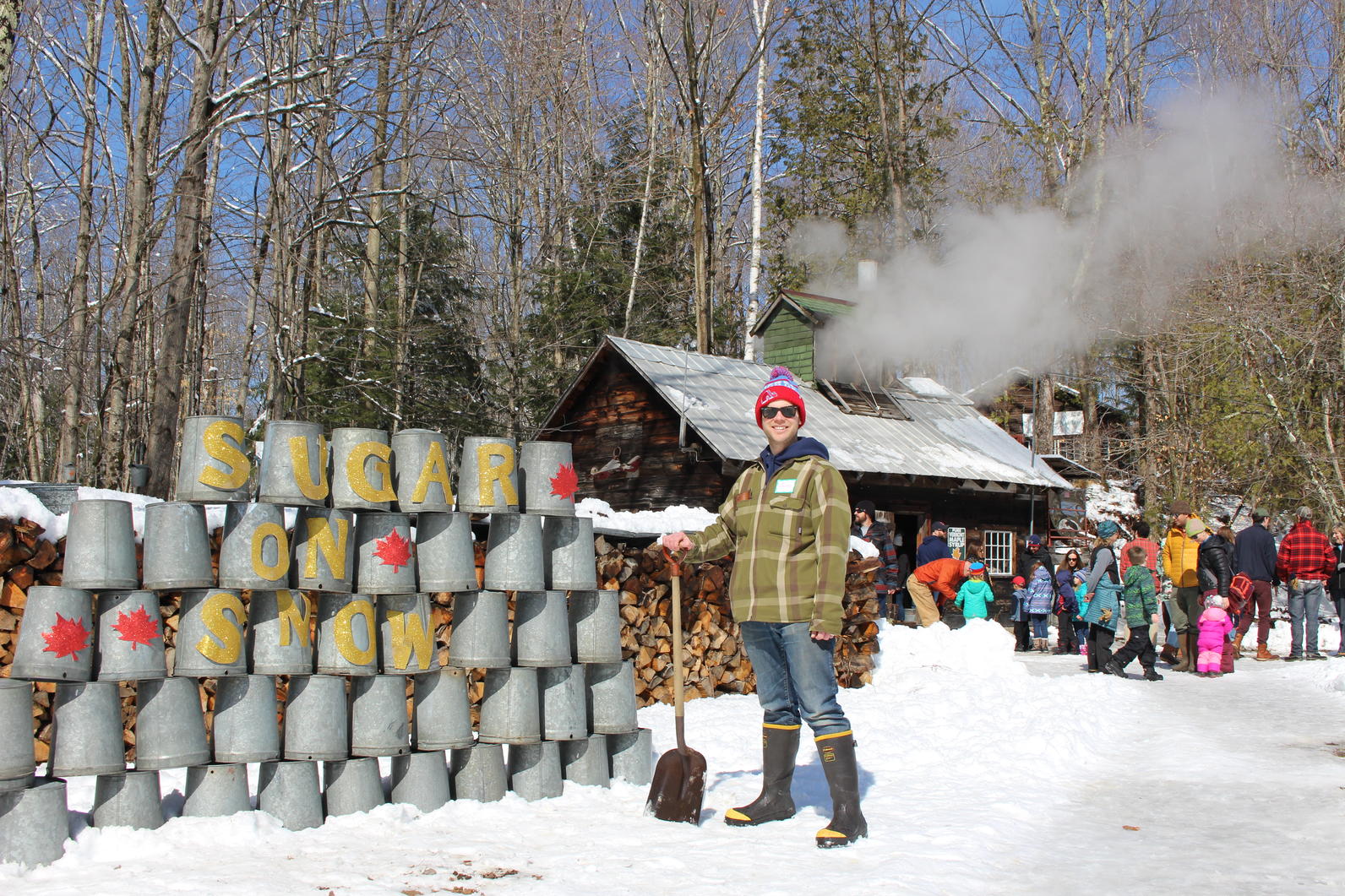
The next day dawns and I choose a 100% polyester shirt: it will be hot again, and we will be hiking around another patch of land for several hours. The drive to the Proctor Maple Research Center winds me through the rolling, pastoral Vermont landscape and I arrive in Underhill to meet Steve and Mark. Mark, as it appears to me, wears several hats: conservation biologist, educator, and land steward, and is able to answer every one of my maple-sugaring-related questions.
The Proctor Maple Research Center is a field research station of the University of Vermont’s Plant Biology Department. The Center has existed since 1946 and focuses on research-based advances of maple syrup production in Vermont. Their projects span from new sap collection techniques, to the effects that tapping has on tree health. Not only are they focused on research, but they also function as a field classroom and lead tours and presentations of their operations. Yearly, they produce 3,000 gallons of maple syrup (some of which goes to the University of Vermont dining halls!).
They’ve agreed to allow Steve (and Mark and I) to analyze their land and draft suggestions to support and improve the landscape for birds. As Steve reminds me, sugarbushes are inherently good for birds, but landowners can intentionally manage with birds in mind to improve them.
Steve, Mark, and I trek out through the sugarbush. We have to dodge blue and black tubing strung across and around trees – this is the modern way to collect sap from trees. The metal buckets are essentially a thing of the past as they rely on a freeze-thaw that changes pressure within the tree (which gets sap to flow). The tubing, however, uses a vacuum to create that pressure difference which yields more sap overall – great news for maple producers in Vermont (Vermont is the leading USA producer of maple syrup).
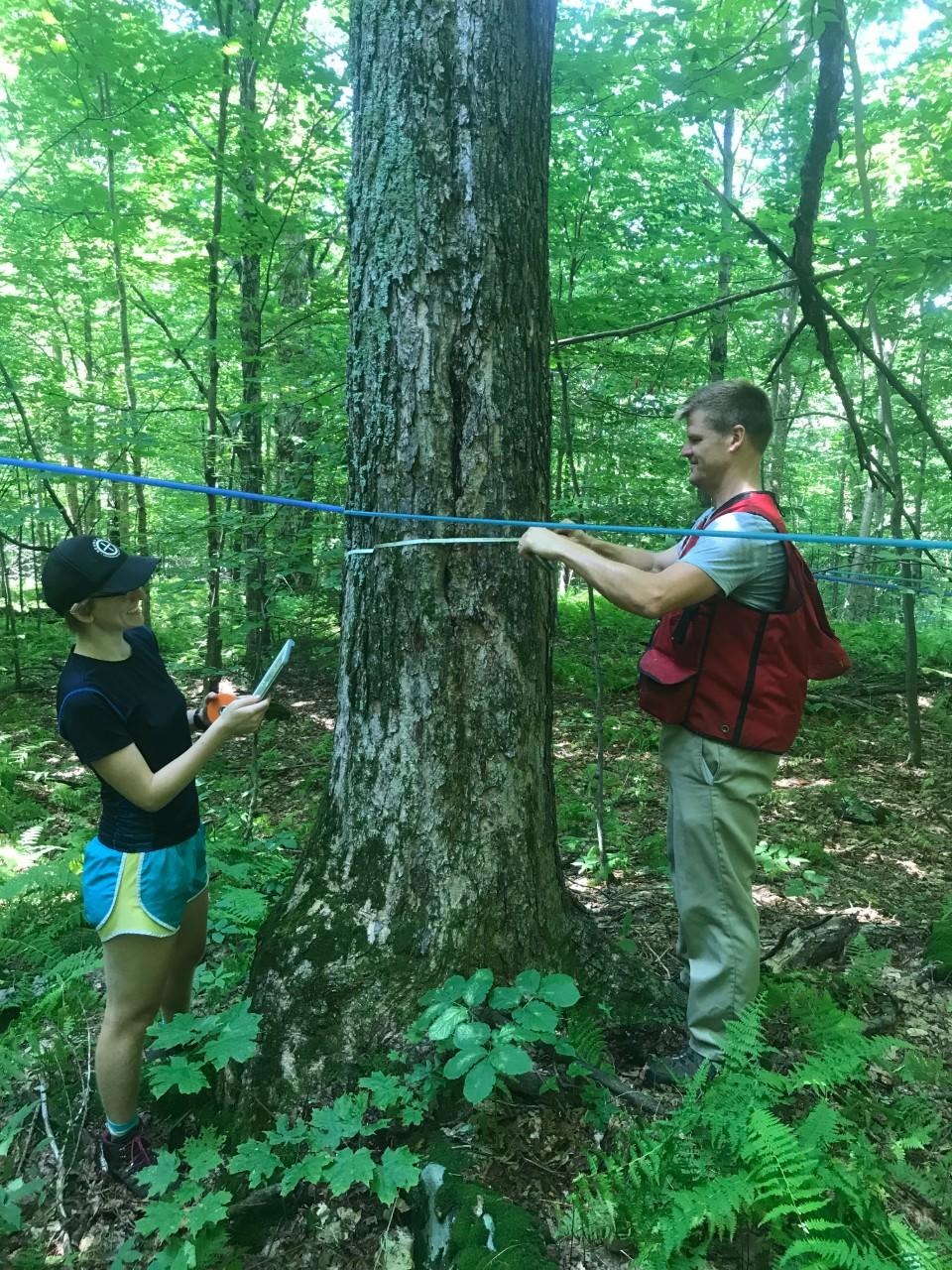
During my questioning, Mark asks me with a grin, “Are you going to ask about if it hurts the tree?” It was, in fact, one of my questions. “We’re doing research on the long-term effects now. But from what we can tell, the tapped trees haven’t produced less sap year after year”.
We survey seven plots with Mark, and then Steve and I survey seven more on our own. “It’s not actually good to have high percentages of every layer of the forest”, Steve tells me. “It’s better to have different habitat elements distributed throughout the sugarbush, because different birds prefer different things.”
After completing the survey, we make it back to our cars and I open all the doors on mine to let it air out. Everything feels too hot and I’m looking forward to the drive back in A/C. Steve will process these results through the Bird-Friendly Maple Sugaring criteria, and draft a report. It will then be up to Proctor Maple Research Center, as to whether the suggestions are feasible.
As for us, we will be surveying another property in northern Vermont later in the week, a partnership between Audubon and Cold Hollow to Canada. “There’s a bit of a backlog,” Steve tells me. It seems like the project is truly taking off!

